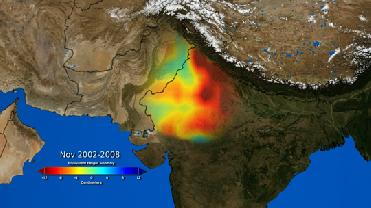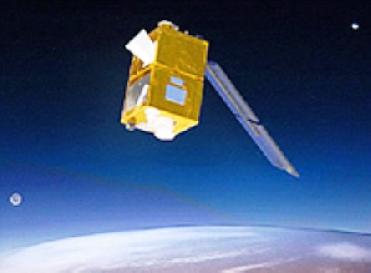
The animated image shows groundwater storage varied in northwestern India between 2002 and 2008, relative to the mean for the period. These deviations from the mean are expressed as the height of an equivalent layer of water, ranging from -12 cm (deep red) to 12 cm (dark blue). Image Credit: NASA
WASHINGTON (BNS): The groundwater level in northern India is depleting at an alarming rate – by as much as one foot per year over the past decade – as per data released by a pair of NASA satellites.
Over 26 cubic miles of groundwater disappeared from aquifers in parts of Haryana, Punjab, Rajasthan and Delhi between 2002 and 2008. A major chunk of it has been consumed by human activity like irrigating cropland, a team of hydrologists led by Matt Rodell of NASA's Goddard Space Flight Center in Greenbelt, Md., has found. It is draining aquifers faster than natural processes can replenish them.
The research results have been published in the journal Nature.
The finding is based on data from NASA's Gravity Recovery and Climate Experiment (GRACE), a pair of satellites that sense changes in Earth's gravity field and associated mass distribution, including water masses stored above or below Earth's surface. As the twin satellites orbit 300 miles above Earth's surface, their positions change relative to each other in response to variations in the pull of gravity.
Changes in underground water masses affect gravity enough to provide a signal that can be measured by the GRACE spacecraft. After accounting for other mass variations, such changes in gravity are translated into an equivalent change in water.
“Using GRACE satellite observations, we can observe and monitor water storage changes in critical areas of the world, from one month to the next, without leaving our desks,” said study co-author Isabella Velicogna of NASA's Jet Propulsion Laboratory in Pasadena, California.
Groundwater comes from the natural percolation of precipitation and other surface waters down through Earth’s soil and rock, accumulating in cavities and layers of porous rock, gravel, sand or clay. Groundwater levels respond slowly to changes in weather and can take months or years to replenish once pumped for irrigation or other uses.
Data provided by India's Ministry of Water Resources to the NASA-funded researchers suggested groundwater use across India was exceeding natural replenishment, but the regional rate of depletion was unknown. Rodell and colleagues analysed six years of monthly GRACE data for northern India to produce a time series of water storage changes beneath the land surface.
“We don't know the absolute volume of water in the northern Indian aquifers, but GRACE provides strong evidence that current rates of water extraction are not sustainable,” said Rodell. “The region has become dependent on irrigation to maximize agricultural productivity. If measures are not taken to ensure sustainable groundwater usage, the consequences for the 114 million residents of the region may include a collapse of agricultural output and severe shortages of potable water.”
Researchers examined data and models of soil moisture, lake and reservoir storage, vegetation and glaciers in the nearby Himalayas to confirm that the apparent groundwater trend was real. The loss is particularly alarming because it occurred when there were no unusual trends in rainfall. In fact, rainfall was slightly above normal for the period.
The only influence they couldn't rule out was human.
“For the first time, we can observe water use on land with no additional ground-based data collection,” said co-author James Famiglietti of the University of California, Irvine. “This is critical because in many developing countries, where hydrological data are both sparse and hard to access, space-based methods provide perhaps the only opportunity to assess changes in fresh water availability across large regions.”
 Previous Article
Previous Article Next Article
Next Article













The Indian Air Force, in its flight trials evaluation report submitted before the Defence Ministry l..
view articleAn insight into the Medium Multi-Role Combat Aircraft competition...
view articleSky enthusiasts can now spot the International Space Station (ISS) commanded by Indian-American astr..
view article